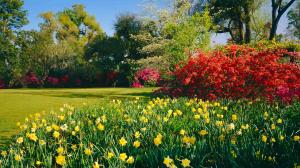
New Exmark Backyard Smart Video Demonstrates How to Plant a Pollinator Garden
Learn how to add beauty and attract pollinators to the yard
BEATRICE, NEB, USA, May 28, 2024 /EINPresswire.com/ -- While it’s widely known that nearly everything on earth needs the help of pollinators like bees, butterflies, moths and hummingbirds, many folks don’t know how easy it can be to support their work. All it takes is a simple garden with a mix of the right flowers and plants.
With this in mind, Exmark recently released a new Backyard Smart video, “How to Plant a Pollinator Garden”, to help homeowners more effectively attract pollinators to their yard.
According to Exmark Director of Marketing, Jamie Briggs, a pollinator garden is not only beautiful, but also extremely beneficial to the environment.
“There’s no avoiding the fact that nearly everything needs the help of pollinators to grow,” Briggs said. “A pollinator garden helps to revive declining pollinator populations by providing pollen and nectar, and it provides the homeowner with a garden full of beautiful blooms.”
While there are an endless variety of pollinator plants, one tip is to stick with varieties that are native to the area, since those are the plant varieties the local pollinators are naturally attracted to. In addition, native plant species are already acclimated to the local environment, so they are typically hardier and require less overall maintenance. Local nurseries or garden centers, or your local extension office, can provide guidance on the right selection of plants for the local environment.
Experts say it’s always best to plant a mix of perennials and annuals, with a plant variety that blooms at different times over the summer and early-fall. Color selection has an influence on which pollinators the flowers will attract. For example, bees typically prefer plants that use bright whites, yellows, and blues, while butterflies prefer red, orange, yellow and purple flowers.
Pollinator gardens can thrive in both sunny and shady conditions, but because many pollinators are airborne, they tend to prefer areas that are protected from gusty wind. Also, adding a small pond or bird bath can be helpful in giving pollinators a nearby water source.
View the Backyard Life: How to Plant a Pollinator Garden video and get links to valuable resources for finding the right plants for any location, on the Exmark Backyard Life site. There, you can also find a wealth of other Exmark Original Series video content, including Done-In-a-Weekend Projects, Dream Yards, and Prime Cuts, as well as content from Exmark-affiliated influencers.
# # #
About Backyard Life
With a focus on giving home and acreage owners tips and know-how to make the most of their outdoor experience and live more life outdoors, Backyard Life is a unique one-of-a-kind multimedia destination. Content focuses on lawn-and-garden, outdoor cooking and living, and rural lifestyles. Learn more at Exmark.com/Backyard.
Matt Gersib
Exmark
+1 402-314-2150
email us here
Visit us on social media:
Facebook
Twitter
Instagram
YouTube
How to Plant Pollinator Gardens
EIN Presswire does not exercise editorial control over third-party content provided, uploaded, published, or distributed by users of EIN Presswire. We are a distributor, not a publisher, of 3rd party content. Such content may contain the views, opinions, statements, offers, and other material of the respective users, suppliers, participants, or authors.



